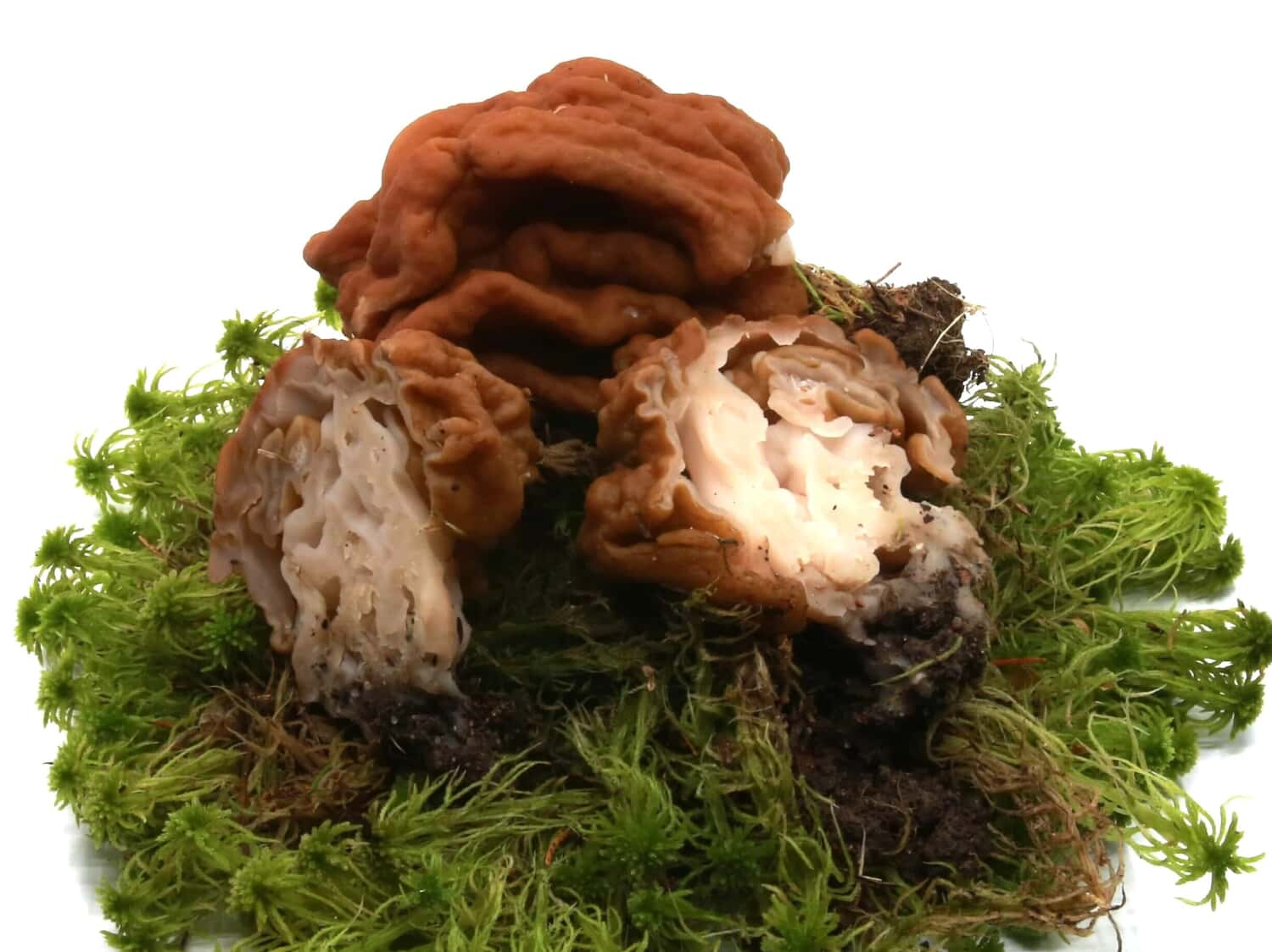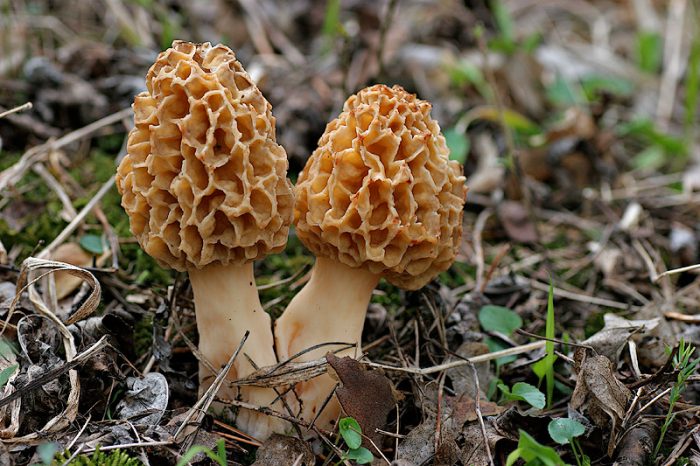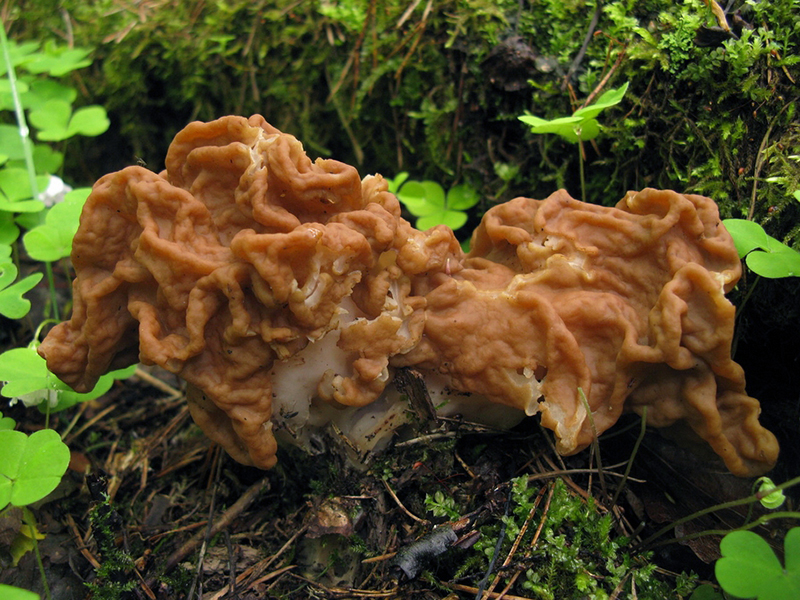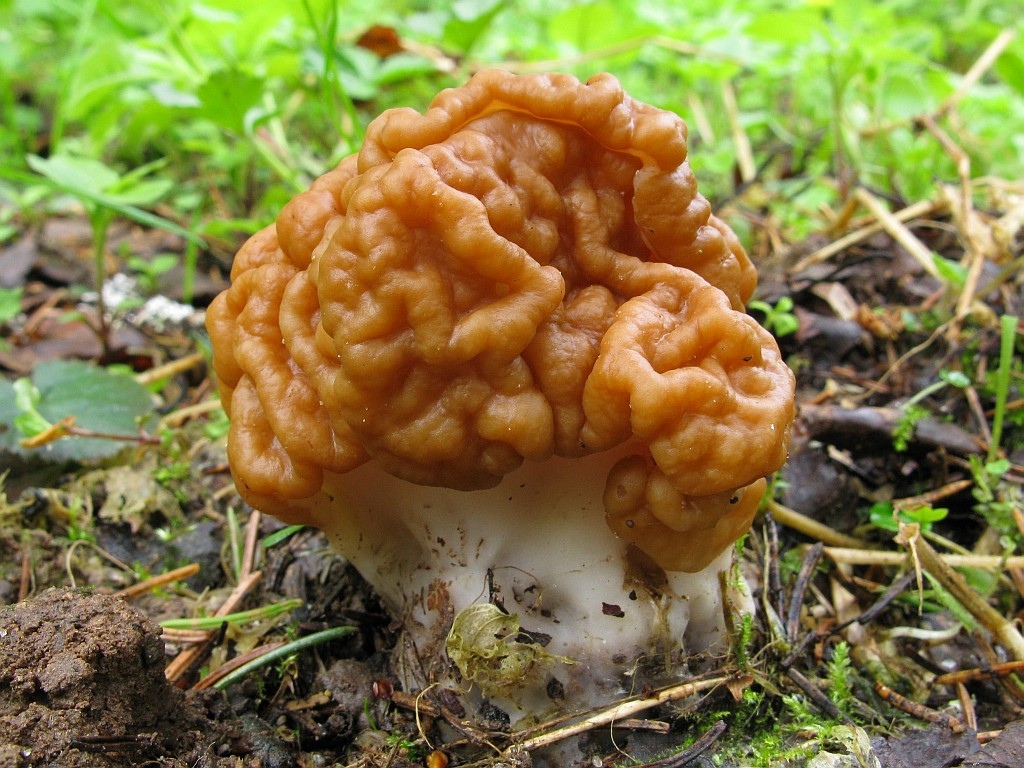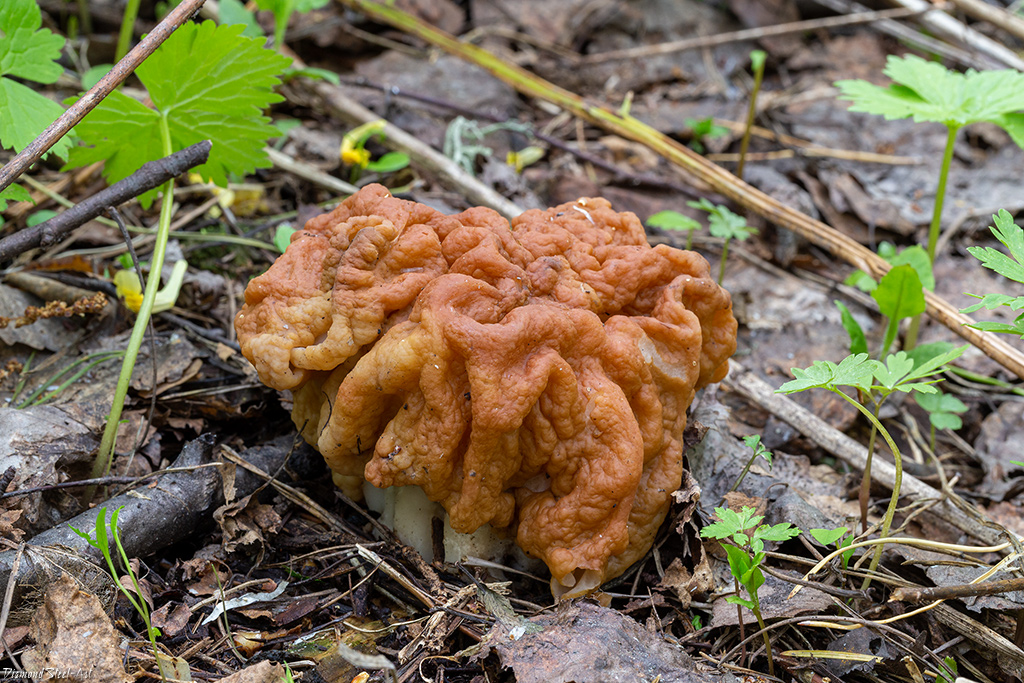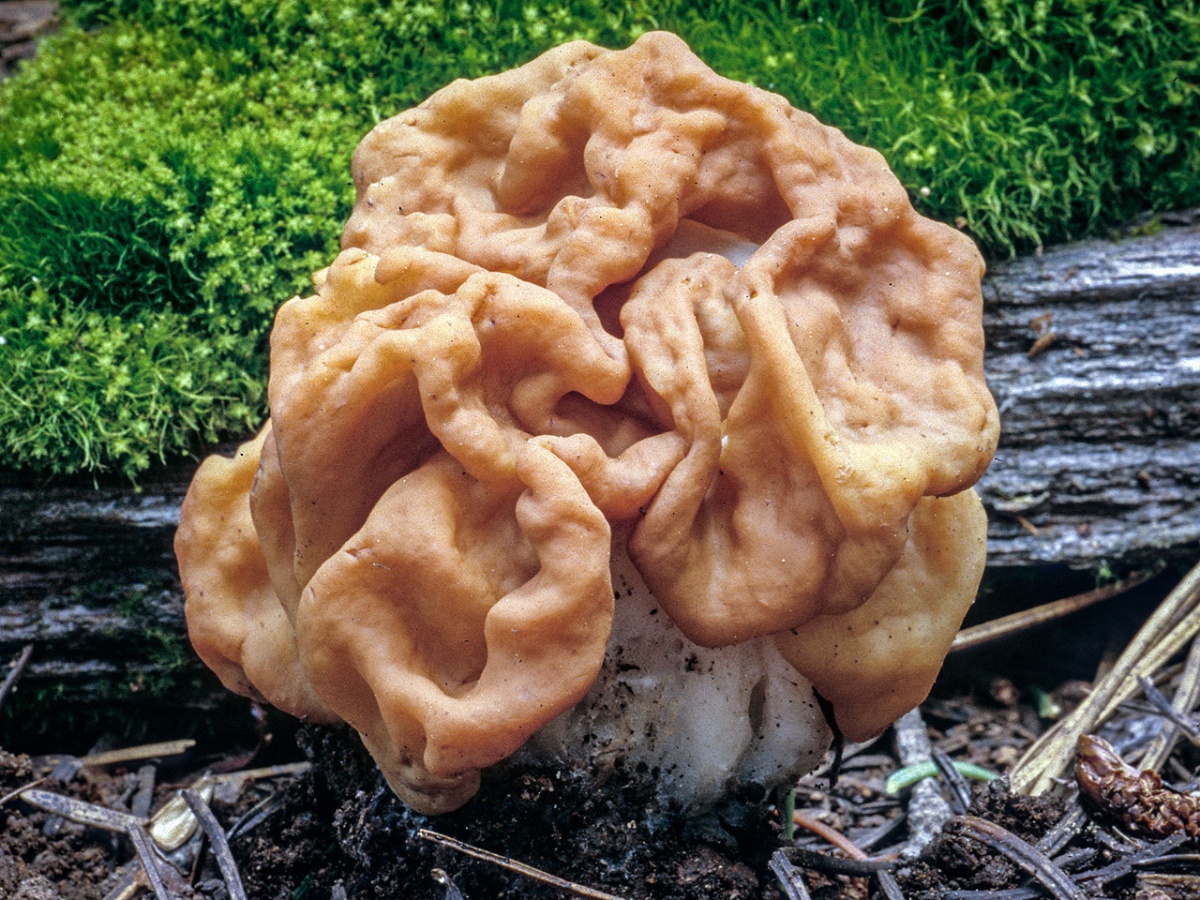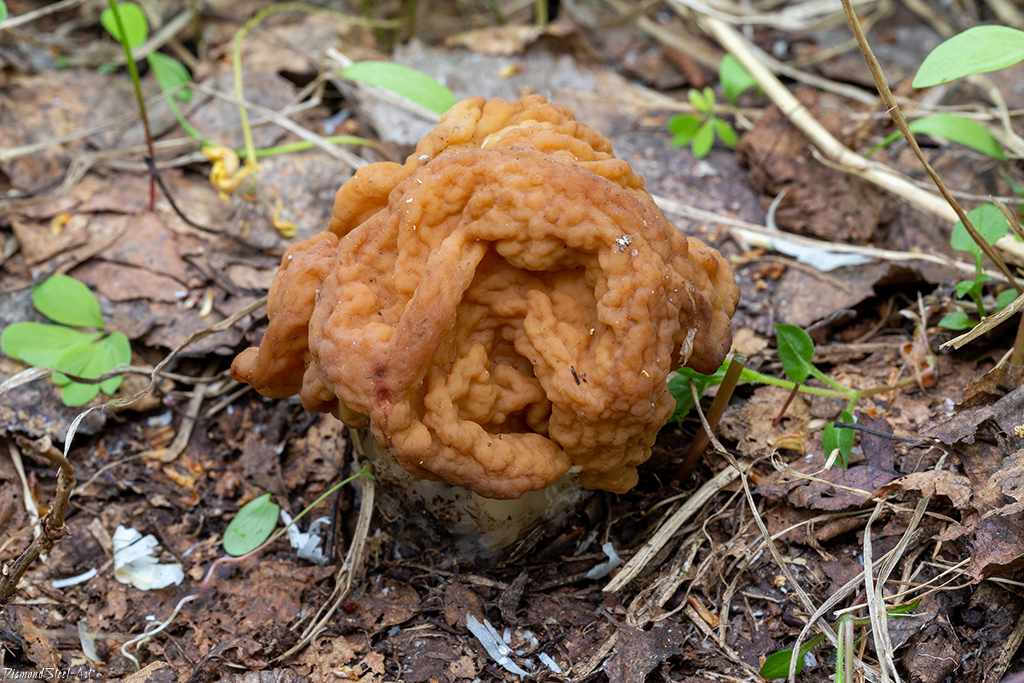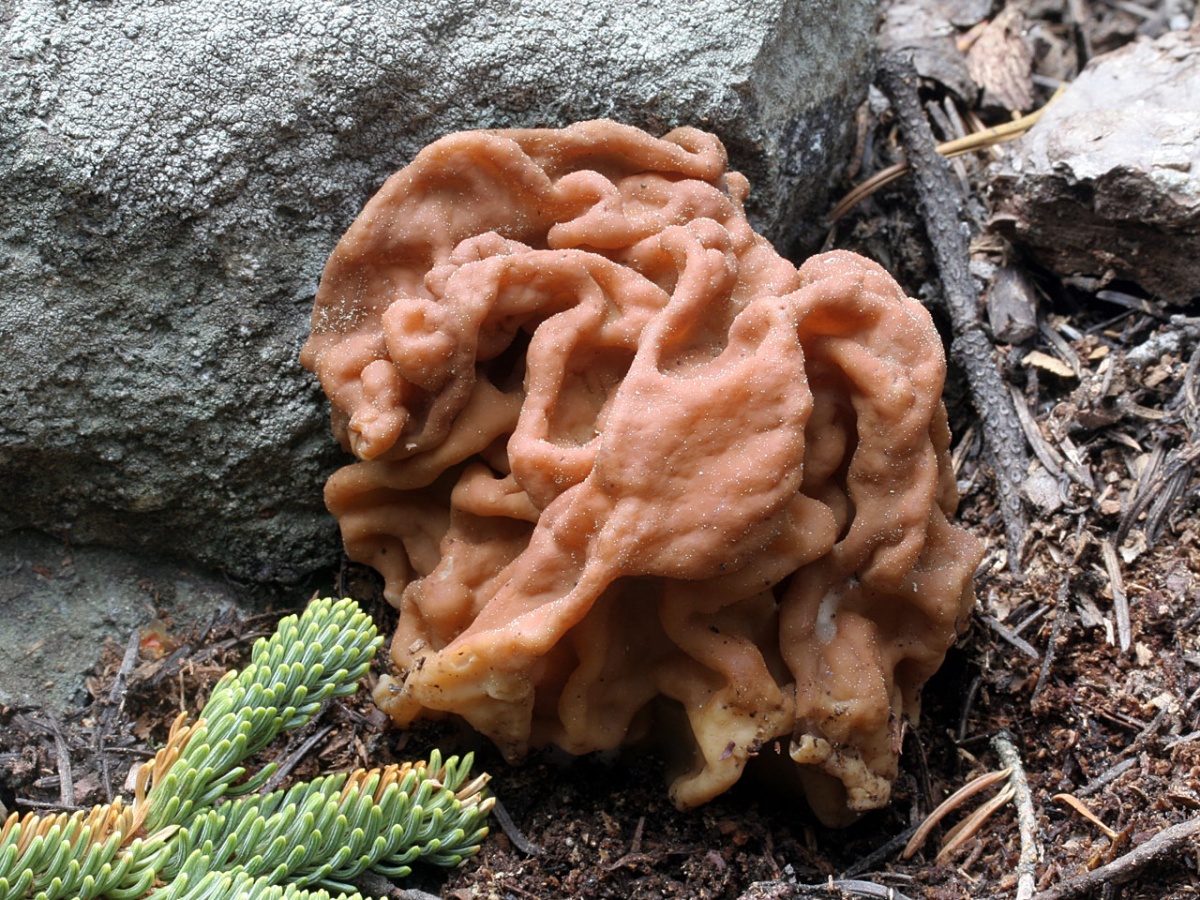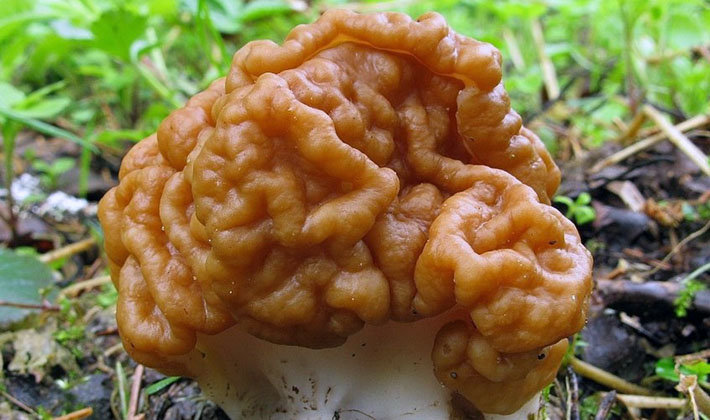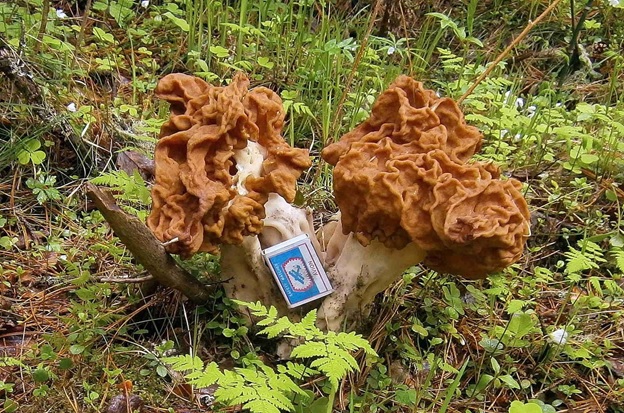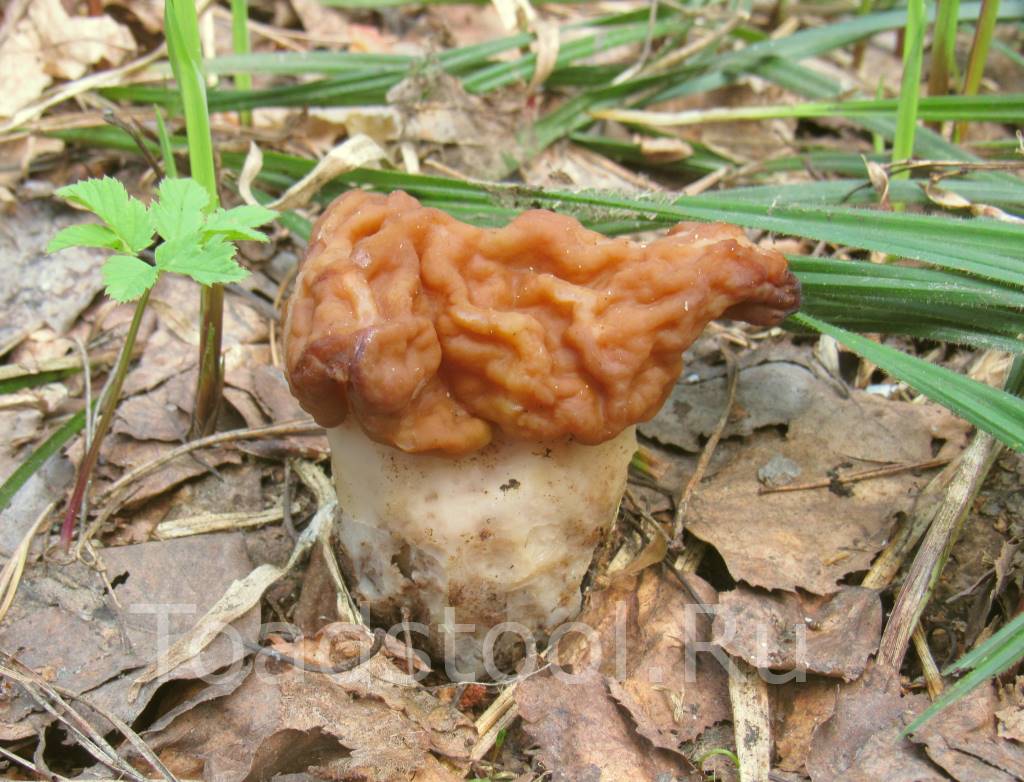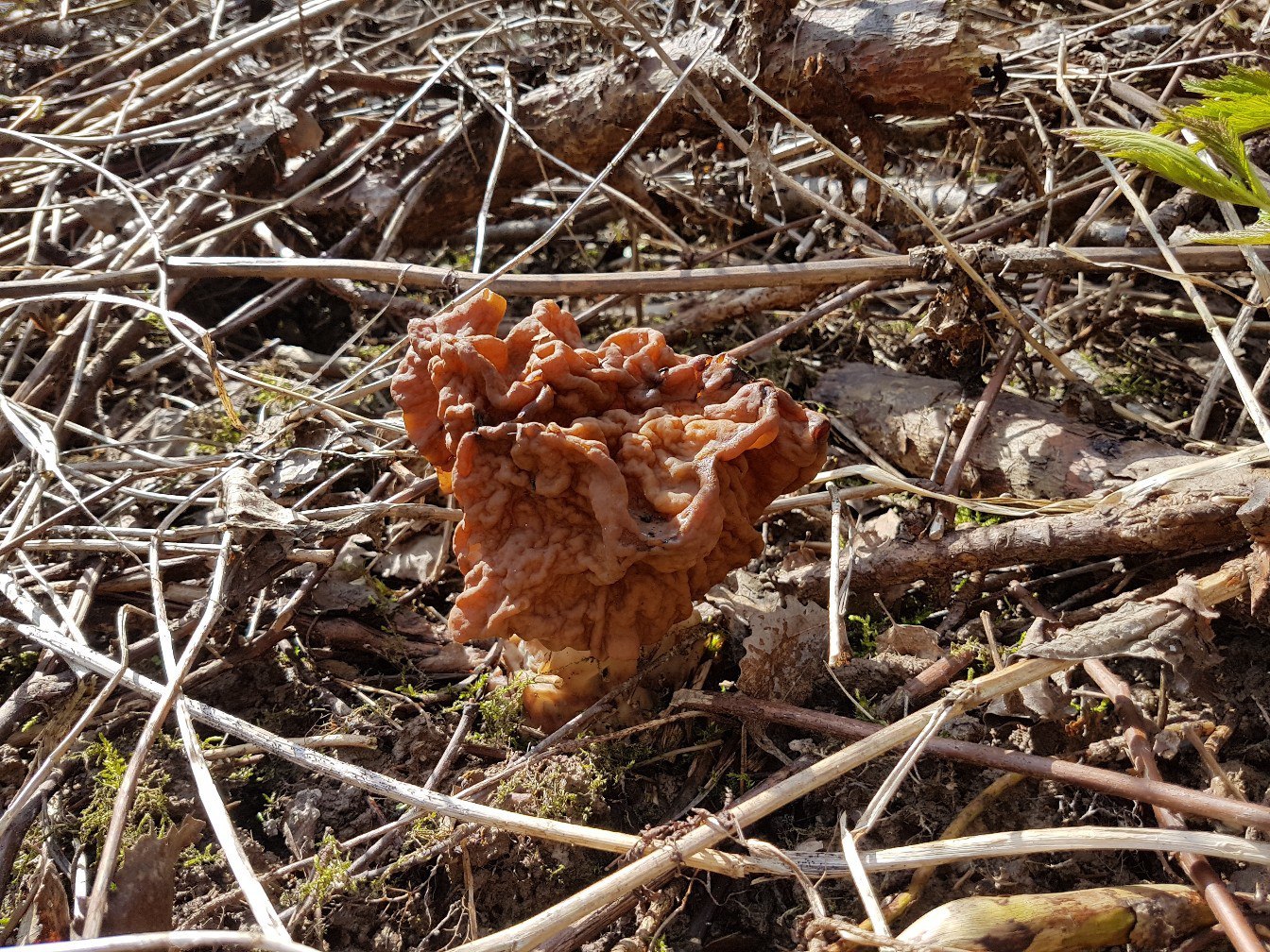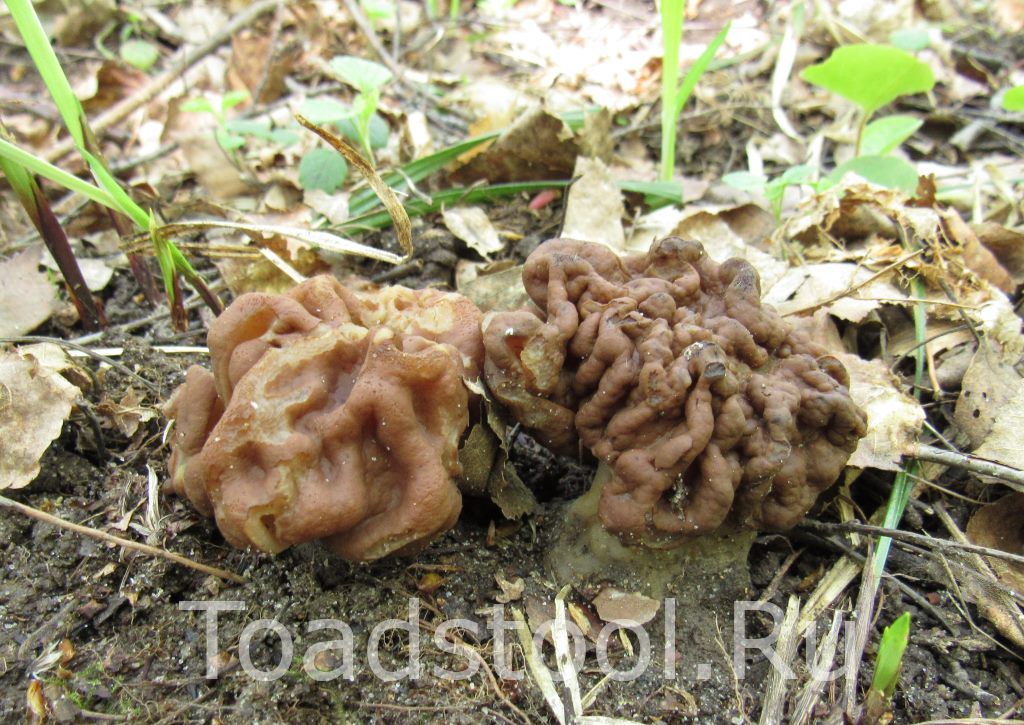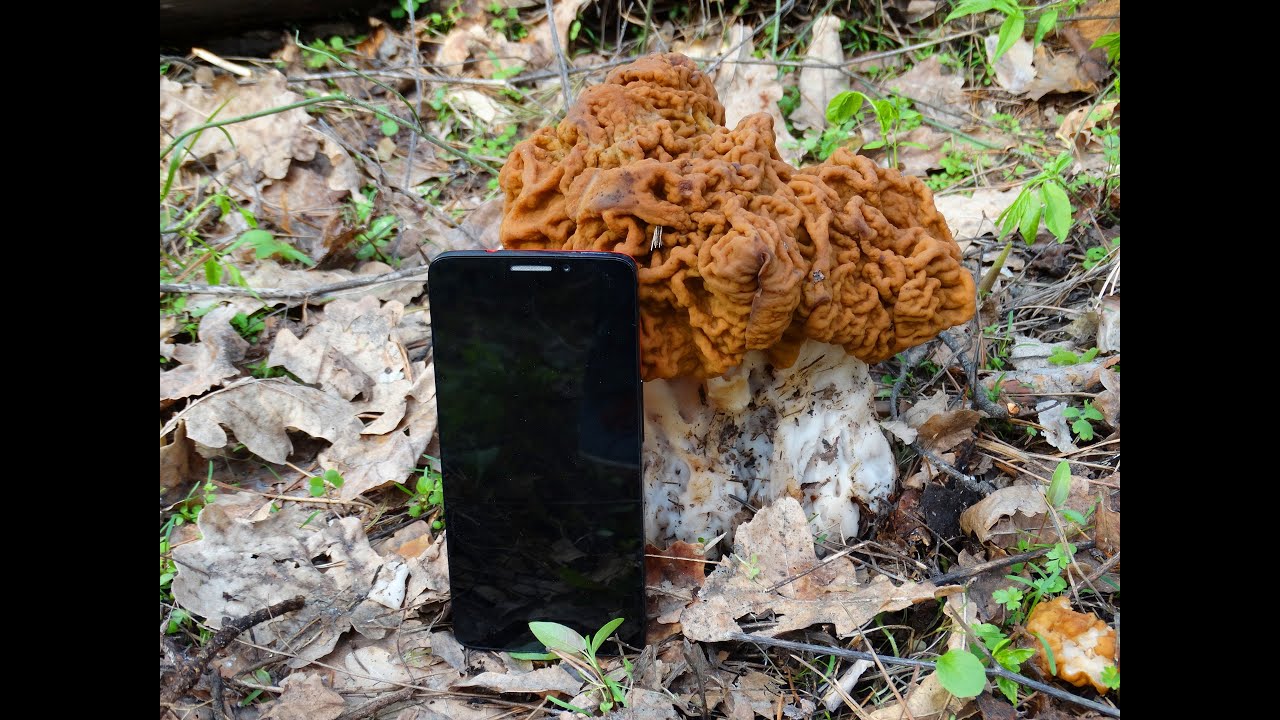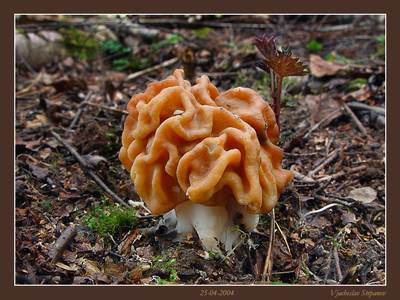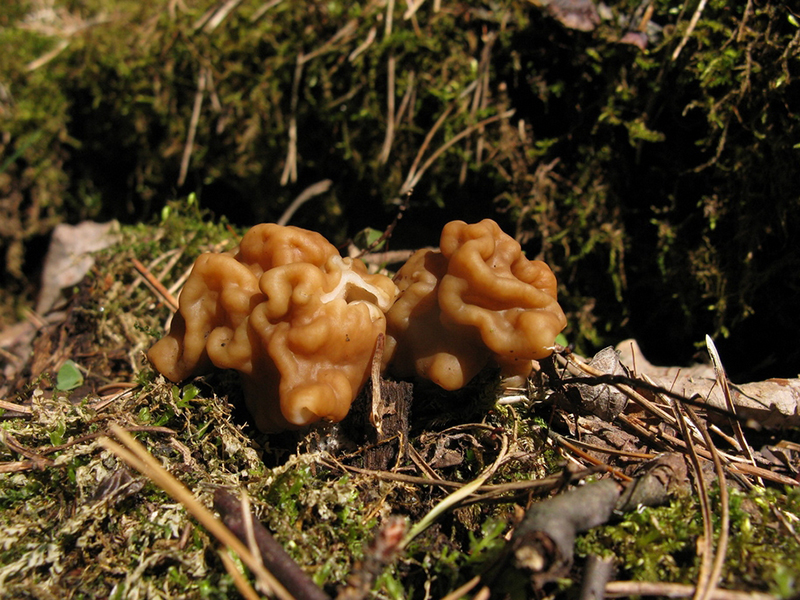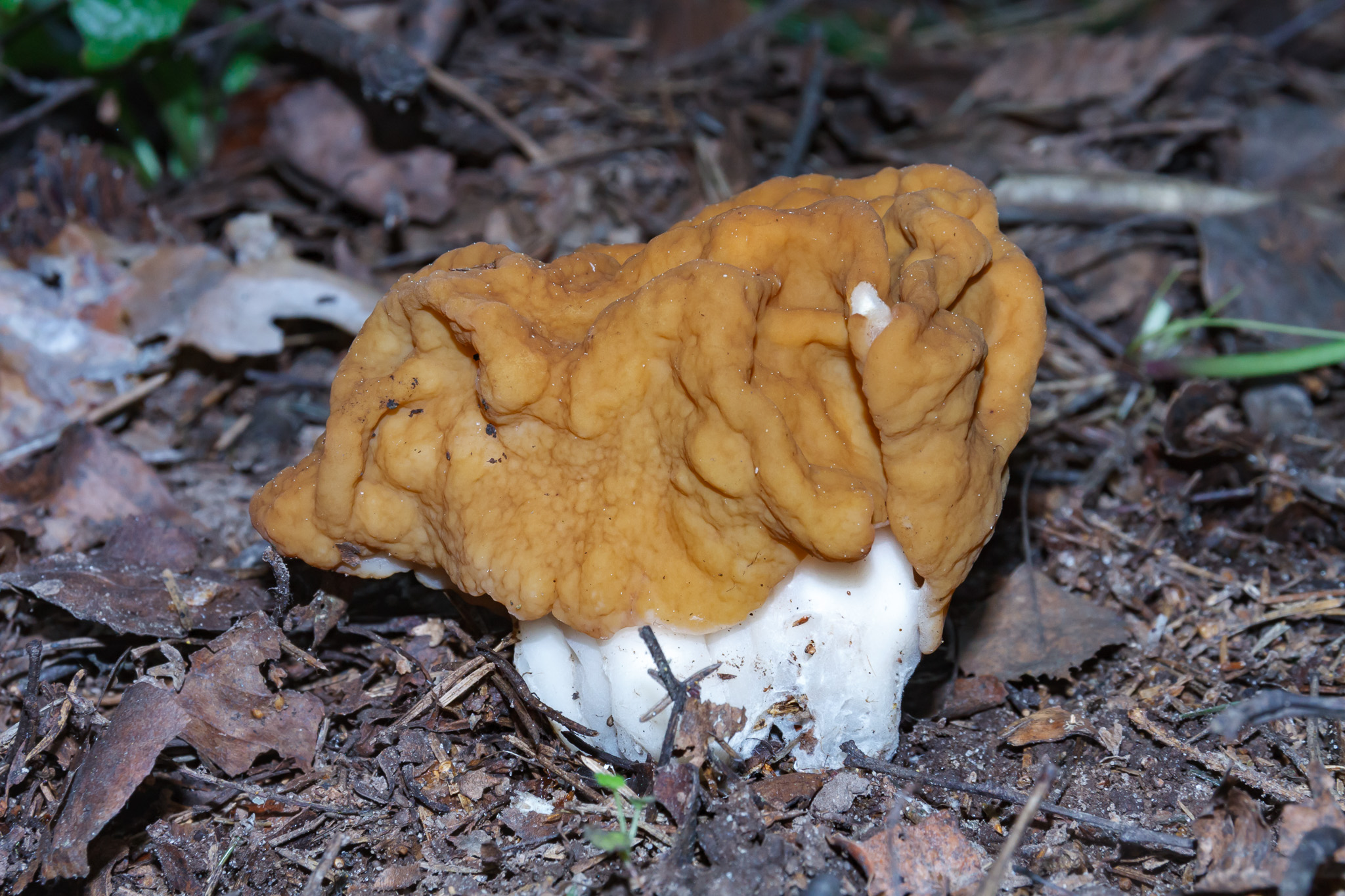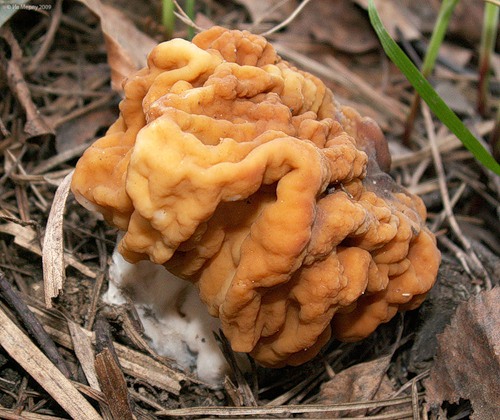Morels description
Morel ordinary, or edible, real (Morchella esculenta). Individual large morels can weigh up to 500 g. Such mushrooms are very impressive in size, since the inside of the mushroom is hollow. The cap (usually 3 - 5 cm in diameter) is ovoid or ovate-rounded, 3 - 6 cm high. At the edges it fuses with the stem. Outside, the cap is yellow-brown, brown, occasionally gray-brown. Uneven, wavy “ribs” create a mesh-like surface with deep, convoluted cells of irregular shape. The leg is fragile, up to 2 cm in diameter, cylindrical (up to 7 cm long), hollow inside, whitish or brownish, smooth or with longitudinal grooves (dents). At the base, it expands. The pulp is thin, fragile, waxy. The height of the cap and legs "by eye" are almost the same. In the cut, the whole morel is hollow inside.
Morel common, or edible, photo from Wikipedia
The conical morel (Morchella conica) is more shade-tolerant and moisture-loving than its closest relative, the common morel. It is also hollow inside. It has a brownish or brownish-gray cap fused with a leg, which turns brown over time. The cap is up to 5 cm in diameter, up to 10 cm high, conical or elongated-ovoid with regular oblong cells. Vertical (with horizontal baffles) "ribs" can be darker, even almost black. The pulp is waxy, with a weak mushroom odor. The leg (2 - 5 cm long and 1.5 - 3 cm in diameter) is cylindrical, hollow, whitish or yellowish, fragile. It is smooth or with dents (folds) in a longitudinal shape. It is stocky or tapered at the base. Some consider the taste of conical morel to be mediocre, others value it above other morels.
Morel conical
There are other edible morels. This is an edible verpa, or morel cap (Verpa bohemica). It grows abundantly in deciduous forests, especially under aspen trees. This mushroom has a brown or yellowish-brown cap up to 5 cm (usually 2 - 3 cm) in diameter, planted on an elongated (6 - 14 cm) cylindrical whitish or whitish-yellowish stem (up to 2 cm in diameter). The hat resembles a bell with a folded surface and wavy-sinuous edges. The cap is attached to the leg only in the central part. The stem can be smooth or have pubescence, small scales. Inside it is hollow, in young mushrooms it is filled with "cotton wool". This mushroom with a pleasant smell also needs to be boiled beforehand.
Morel cap, photo from the site.
Rarer is a tall morel (Morchella elata) with a height of 25 - 30 cm, with an olive-brown conical cap. It appears in grassy places, loves forest edges, coniferous forests (especially in the mountains) and fireplaces.
Quite rare is the steppe morel (Morchella steppicola), which can be found in the wormwood steppes of Central Asia. The mushroom is edible.
Application
Medicine
Traditional medicine recommends using alcohol tincture from Strochka for a number of diseases:
- arthritis;
- osteochondrosis;
- radiculitis;
- rheumatism;
- neuralgia;
- myopia, cataracts;
- myositis;
- diseases of the pancreas.
Mushroom tincture strengthens the immune system
The tincture is prepared from 30 g of dried pulp and 0.5 l of vodka. The mixture is infused in the refrigerator for 14 days. Then it is rubbed into painful joints, wrapped in warm clothes. The procedure is carried out no more than 3 times a day.
The tincture is carefully consumed inside: it is diluted in a 1: 1 ratio with honey and drunk 5 ml per day. The course to strengthen the immune system lasts 2 weeks. If a rash appears at the application sites or there are other symptoms of non-perception, consult a doctor.
Cooking
The fruit is not consumed in its raw form. As part of safety, it should be boiled twice for 15 minutes. or soak in water and then boil. After that, the trophies are pickled, salted, fried, stewed in sour cream or with cream.The broth is not used after boiling.
- The species tolerates deep freezing and drying well:
- The pulp is considered safe after 4 weeks of drying.
- At temperatures from -18 ° C, the workpiece is stored for up to a year.
- Fresh fruits are stored in the refrigerator for up to 3 days.
Before processing, the fruits are carefully sorted out and washed.
Interesting Facts
Mycologist, author of books on mushrooms, Mikhail Vishevsky, expresses the opinion that the toxicity of the lines depends on the places where they grow, since their chemical composition differs in different areas, and, therefore, toxicity. Thus, he considers mushrooms growing in Western Europe to be poisonous and unsuitable for food, and those growing to the east, including in Russia, are insufficiently poisonous and suitable for food.
The sale of stitches is prohibited in Italy.
Mushroom pickers need to be careful when handling ordinary stitching. These gifts of the forest require careful culinary processing, and only after it can they be eaten. If you are not sure whether the line is in front of you or some other mushroom, it is better not to risk it and not take a suspicious specimen to the basket.
Cooking
When asked if it is possible to eat the lines of mushrooms, the answer is yes. In Europe and North America, despite their confirmed toxicity, they are considered a delicacy. Young mature mushrooms are harvested for drying and boiling in Finland, Spain, Bulgaria and other countries, including Russia. At the same time, the official sale of lines in Germany, Italy, Switzerland, Sweden and Russia is prohibited. An interesting fact - Russian mushrooms contain less toxic substances, apparently, the lack of heat affects.
In France, they are grown artificially. The method is simple, it can also be used at home:
- choose a sunny site;
- collect leaves, dry forests, waste wood in a heap;
- everything burns;
- the lines cut into pieces are scattered on the ash;
- next April, the first few mushrooms are expected to appear, a bountiful harvest can be harvested in 5 years.
The unequivocal verdict of scientists is that you cannot eat raw lines. After proper processing, it is an excellent product with a delicate taste and pleasant smell. Experienced chefs advise to approach mushrooms responsibly:
- rinse the mushrooms thoroughly with cold water, remove debris and earth;
- prepared mushrooms are poured with water at the rate of 3 liters per 1 kg;
- the product is boiled for at least 20 minutes;
- the water is drained, the mushrooms are washed in running water;
- repeat the boiling of the lines;
- again drain the water and rinse again under running water.
Be sure to cook in an open container and with an open window. During the heat treatment, toxic substances are released. Now the mushrooms are ready for further use - frying, drying, conservation. The lines that have become edible mushrooms (photo of the dish in the text) are used to prepare soups, main courses, snacks, sauces, as a filling for baking. However, it is worth noting that if you are not sure that the mushrooms are cooked correctly, it is better to refuse to use them.
Mushroom in the diet
An ordinary line is a toxic mushroom.
Nevertheless, in many countries, including Russia, this mushroom is eaten, processing it properly, usually using two or three boiling times.
In Russia, statistics of poisoning with this fungus are absent or, as usual, classified, although most likely no one simply collects it, so let's turn to the Western countries.
Most of the poisoning with this type of mushroom occurs in Eastern Europe, mainly in Germany, Poland and Finland. In North America, poisoning occurs in Michigan, Idaho and Western Canada.
From 1953 to 1962, 138 poisonings were recorded in Poland with two deaths.
Between 1994 and 2002, the Swedish Poison Control Center received 706 non-fatal stitch-related calls.
In the United States, between 2001 and 2011, poison control centers received 82,140 fungal cases. Of these, 448 were associated with these lines.None of these were fatal, but nine people developed acute liver damage.
The peak of poisoning occurs mainly in the spring, as this mushroom grows at this time.
This gib contains the toxin gyrometrin. The toxin was found in this mushroom back in 1885, and was then called Helvelic acid, which is now known to us as gyromitrin.
Symptoms of poisoning occur within 5 hours after use in the form of a malfunction of the gastrointestinal tract, a feeling of nausea and vomiting appears, then within 2 days liver damage occurs, in the absence of medical care it can be fatal.
Several mushroom websites and guides describe boiling and drying techniques to render the mushrooms harmless and edible. Theoretically, 99% of gyromitrin can be removed by drying or boiling the mushroom before using it, however, it will still not get rid of it completely, so the risk of poisoning is always possible.
Studies of Western scientists in 1991, based on experiments on animals, deduced the following lethal doses of gyromitrin toxin poisoning from 25 mg / kg to 50 mg / kg for adults and from 10 mg / kg to 30 mg / kg for children. This corresponds approximately to 0.4 kg to 1.0 kg of fresh raw mushroom for an adult and 0.2 kg to 0.6 kg of fresh mushroom for a child.
INTERESTING:
the symptoms that appear in those who have been poisoned by these mushrooms are similar to the symptoms of poisoning of workers in the space industry, who were poisoned while working with rocket fuel.
For space workers, this is due to the fact that they are exposed to the poisonous component of rocket fuel, monomethylhydrazine (MMH).
It turns out that stomach acid breaks down the gyrometrin toxin to produce the same MMH component that Aerojet's Aerozine-50 propellant is used in the American Titan rockets.
How not to get poisoned with a line?
The authors of foreign reference books and determinants call the line a deadly poisonous mushroom. In some Western countries, the sale of stitches is prohibited.
In the USSR, the line was allowed by GOST in the blank and was considered a conditionally edible mushroom. At that time, the cause of the line poisoning was considered to be Helvelic acid. That is why there was a recommendation to pre-boil the mushroom for 10 - 15 minutes, and then drain the water. Unfortunately, such preliminary preparation of lines did not always save people from terrible poisoning. They often ended tragically. In the process of studying the lines, it turned out that they do not contain Helvelic acid, but there is another toxin - gyromitrin. It is its action that causes poisoning, similar to poisoning with the poison of the pale toadstool. In some lines, the concentration of gyromitrin is high, in other mushrooms this toxin accumulates less. Then poisoning is avoided. Professor S.G. Musselius, who for many years not only studies the effect of poisonous mushrooms on the human body, but also pulls people out of the afterlife, explains it this way:
German scientists found that in fresh lines collected in Germany, many fruiting bodies of mushrooms had 1676 mg / kg of gyromitrin. They noted that the results of analyzes of strings found in some other countries turned out to be much better ("Plant Life", Vol. 2 "Mushrooms").
Most of the cases of line poisoning occur when people do not boil them beforehand or boil them for 5 to 10 minutes. For lines, the minimum boiling time, according to S.G. Musselius, - 25 - 30 minutes. During this time, some of the compounds of gyromitrin pass into a decoction, and some are destroyed. 1 kg of mushrooms requires about 2.5 - 3 liters of water. Not less! In most reference books for mushroom pickers, the lines are advised to boil for 10 - 15 minutes, then drain the broth, do not try. Doctors, who have had to save people poisoned with lines more than once, advise to boil mushrooms twice, pouring fresh water.After each time, you need to rinse the mushrooms with clean water. Repeated use of the decoction is only harmful, since the concentration of the toxin is greatly increased in the mushrooms. And this threatens the development of acute renal failure. The use of the lines prepared in accordance with all the rules may end badly several times in a row. The interval between meals with lines should be at least two days. Frequently repeated use of lines causes general malaise, which ends with jaundice. It is worth saying that there are lucky ones with a low individual sensitivity to the poison of the lines.
Professor S.G. Musselius introduces the clinic of poisoning with lines. It is useful for lovers of these spring mushrooms to know. The first symptoms of poisoning appear 3 to 25 hours after the lines have been eaten. These are abdominal pain, nausea and vomiting, diarrhea. The urine turns pink. During this period, the breakdown of red blood cells occurs. On the second - third day, the poison begins to infect the kidneys and liver. In severe cases, unconsciousness develops on the third - fourth day. It is accompanied by cutaneous hemorrhages, jaundice, increased heart rate and decreased blood pressure. Further, all hope is only on God and on doctors, who often have to connect an "artificial kidney".
For those brave souls who have not lost the desire to try their luck for the sake of a plate of stewed lines, here are a couple of recipes for delicious lines in sour cream. Just in case, in the article "How to call emergency services from a mobile phone?" you can check the numbers of Ambulance and rescue services.
Toxicity of Giant Stitches and Eating Them
It is believed that the lines are giant after heat treatment, they can be used for food, but the toxin gyromitrin is not completely destroyed, even with prolonged boiling, in connection with these lines, they are certainly considered poisonous mushrooms.
All raw lines contain strong toxins that have a hemolytic effect, in addition, they destroy the liver, central nervous system and the gastrointestinal tract. Eating uncooked stitches or broths made from them can cause serious poisoning, even death.
To remove toxins from giant lines, they are boiled for 15-30 minutes, then the broth is drained, the mushrooms are washed in water or the lines are dried in the open air. It is advisable to do a double boil. When boiled, methylhydrazine turns into a decoction, and when dried in air, it evaporates. After such processing, the giant lines are eaten in many countries, including ours. But digestion does not completely destroy toxins, the best way is to dry the mushrooms for a long time at a high temperature, they can also be dried in the open air for 6 months.

In any case, you must be extremely careful when eating lines in food. Firstly, even after boiling or drying, a small amount of toxins remains in the mushrooms, which can be carcinogenic. And, secondly, some people, especially children, may be hypersensitive to toxins, so even a small amount of poison can kill these people.
There was a version that there are special strains of stitches, which contain an increased amount of gyromitrins, in these cases, the digestion is ineffective.

Giant stitching - Gyromitra gigas
Written by Nikolay Budnik and Elena Meck.
The giant line is a wonderful spring mushroom. The heart stops and the soul sings when you meet a scattering of giant lines in the forest!
These mushrooms are fleshy, dense, juicy, the size of a fist and even more. Inside, the mushrooms are not empty, like ordinary lines. Both the leg and the cap are filled with folded pulp, so the mushroom is weighty, even heavy.
Giant Stitches do not have the poison of gyromitrin, which Strochk ordinary has. The lines are gigantic fried. It turns out very tasty and aromatic! Mushrooms are also suitable for drying.
1. Giant line - one of the first spring mushrooms.
2. He appears on Ulom Zheleznaya in early May.
3.It grows until the last days of May.
4. It happens that a giant line is found in early June.
5. In the photo you can see that the grass has just emerged from the ground.
6. And here the grass is already bigger.
7. Sometimes a giant line grows among the fallen leaves.
eight. . among last year's needles and leaves.
9. Nice to find such a mushroom!
10. In old age, the mushroom dries up. Here, moreover, it became moldy.
11. Giant stitching is usually found in dry, well-warmed places.
13. He can be seen among the blueberries.
fourteen. . in a mixed forest where pines, birches and Christmas trees grow.
15. Mushrooms can also be found on the forest edge among the grass.
16. . and in a well-lit forest glade.
17. Giant lines live up to their name and reach large sizes.
18. In damp places, the leg is pulled higher.
19. . and in drier ones, the cap is larger.

19a
Pay attention - there are many small mosquitoes in the folds of the mushroom on closer inspection!. twenty
The mushroom can be very light
20. The mushroom can be very light.
21.. or darker.
23. And this mushroom is larger than a palm!
24. The cap of the giant's line is covered with convolutions and looks like a human brain.
25. Sometimes it becomes overgrown with blades of grass or twigs.
26. The color of the hat ranges from light brown to dark brown.
27. The leg is almost always dirty white.
28. It can be thinner than the cap or almost as thick as the cap.
29. And this is how giant lines look when torn off.
30. This is a very weighty mushroom.

31. From the inside, it is not hollow, but rather dense.
32. With such a dense, and not empty interior, a giant line differs from an ordinary line.
33. This can be seen in the section of the mushroom.
34. A dozen giant lines will be enough for a good roast. We boiled them before, and then fried them. Now it turned out that the Giant Lines have no poison, so they began to fry immediately. The taste has become richer and more pleasant!
35. In the basket you see giant lines together with morel caps, because they grow at the same time and in almost the same places.
36. Such a harvest was in 2012, and in 2013 there were almost no such mushrooms.
And now a short film about the collection of giant lines.


